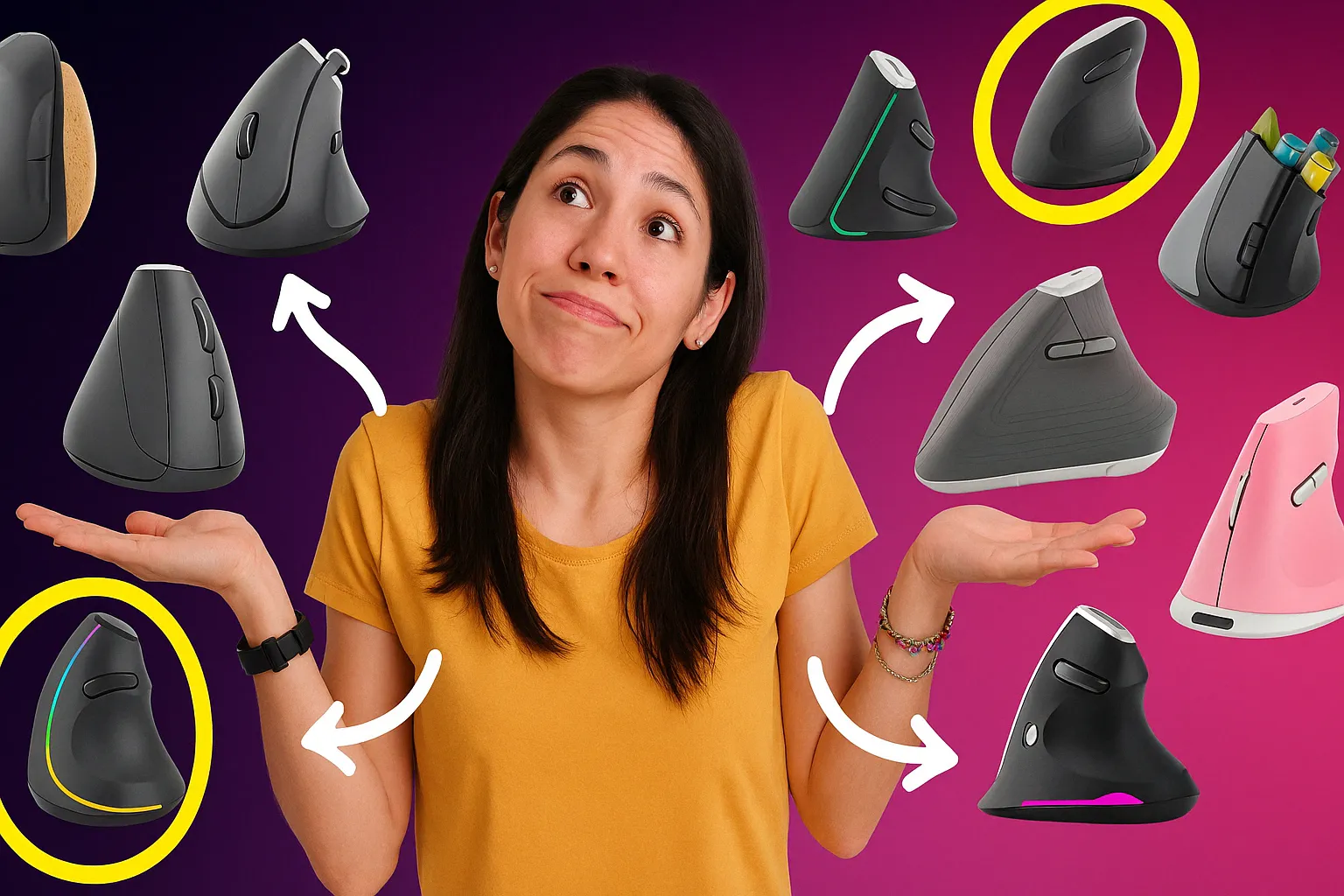Spending hours in front of a computer can lead to discomfort and even pain. An innovative solution that’s gaining popularity is the wireless vertical mouse, which promises better ergonomics. But does it really work, and is it right for you?
In this comprehensive guide, we analyze everything about the wireless vertical mouse. We’ll explore its design, benefits, limitations, and how it compares to traditional mice. Get ready to find out if this peripheral can revolutionize your usage experience.
What Defines a Wireless Vertical Mouse?
Imagine shaking hands with someone—this is the posture a vertical mouse aims to replicate. Unlike conventional mice that force your palm down, the vertical design positions your wrist at a more natural angle, typically between 57 and 90 degrees.
This orientation reduces forearm twisting, known as pronation. By relieving tension on muscles and tendons, it serves as a powerful ally against discomfort. The wireless connectivity, whether via Bluetooth or USB receiver (dongle), adds freedom of movement and creates a cleaner workspace.
Clear Advantages: Comfort and Productivity
Wireless vertical mice offer a range of benefits that go beyond modern aesthetics. They are designed with user health and efficiency in mind for long working hours or extensive use.
The main advantage lies in enhanced ergonomics, but factors such as mobility and extra functionalities also stand out. Let’s delve into the most significant positive aspects.
Key Ergonomic Benefits
- Natural wrist posture
- Reduced muscle tension
- Relief from repetitive strain injuries (RSI)
- Comfort during prolonged use
- Prevention of future injuries
- Thumb support
Mobility and Easy Connectivity
- Total freedom without cables
- Stable connection (Bluetooth/USB)
- Wide wireless range
- Portable design
- Multi-device options
- More organized setup
Features that Enhance Usage
- High-precision sensors
- Adjustable DPI (sensitivity)
- Programmable extra buttons
- Long battery life
- Fast charging available in some models
- Smooth clicks and scrolling
- Options with silent clicks
Challenges and Limitations to Consider
Despite the significant advantages, the wireless vertical mouse isn’t without drawbacks. It’s vital to understand the negatives before making a purchase to ensure it aligns with your needs and expectations.
The initial adjustment and certain design or usage limitations can be barriers for some users. Analyzing these cons helps you make an informed choice.
Learning Curve and Precision
- Adjustment period required
- Awkwardness in the initial days
- Fine precision may require practice
- Less intuitive for gaming
- Detailed editing can be challenging
Design and Usage Constraints
- Few options for left-handed users
- Size can be bulky
- Requires more vertical space
- Not optimized for gaming
- Potential latency (rare)
Cost and Other Factors
- Tends to be pricier
- Premium models can be expensive
- Risk of losing the USB dongle
- Maintenance (batteries/recharging)
Vertical vs. Traditional: What’s the Real Difference?
Understanding the fundamental differences between a wireless vertical mouse and a conventional mouse is key to choosing the right device. A direct comparison helps visualize where each one excels.
We analyze the key aspects, from ergonomics to functionality, so you can weigh which format best meets your daily use profile.
Essential Comparison Table
| Feature | Wireless Vertical Mouse | Traditional Mouse |
|---|---|---|
| Ergonomics | Neutral posture (hand) | Palmed down (pronation) |
| Grip | Handshake style | Palmed, claw, fingertip |
| Movement | Less wrist/hand movement | Wider movement |
| Adjustment | Requires some time | Usually intuitive |
| Main Focus | Comfort and health | Versatility and variety |
| Average Price | Moderate to High | Low to High |
How to Choose the Ideal Vertical Mouse for You?
Choosing the perfect wireless vertical mouse depends on your individual needs. Considering some key factors can help narrow your search and ensure satisfaction with the product.
From your hand size to the type of work you do, every detail matters. Consider your budget and the features that are essential for your routine.
Crucial Factors in Your Selection
- Hand size
- Right or left-handed use
- Purpose (work, general use)
- Need for extra buttons
- Preferred type of connection
- Available budget
- Desired battery life
Premium models like the Logitech MX Vertical offer advanced features and superior ergonomics but come at a higher price. More affordable options like the Logitech Lift cater to smaller hands and include a left-handed version. Brands like Delux offer budget-friendly alternatives that sacrifice some extra features but maintain essential ergonomics.
Frequently Asked Questions about Vertical Mice
Still have questions about the wireless vertical mouse? We’ve gathered some of the most common queries to clarify remaining points and assist in your final decision.
These quick answers address common concerns about adjustment, gaming use, and real health benefits.
Quick FAQ
- Is it difficult to get used to a vertical mouse?
Yes, there is a learning curve. Most users take anywhere from a few days to a couple of weeks to feel completely comfortable and regain previous precision.
- Is a wireless vertical mouse good for gaming?
Not ideal for competitive gaming that requires speed and extreme precision. It prioritizes comfort over performance in games, although it works fine for casual gaming.
- Are there vertical mice for left-handed users?
Yes, but options are more limited. Models like the Logitech Lift offer specific versions for left-handers, but most of the market focuses on right-handed products.
- Does it really help with wrist pain?
Many users report significant relief from pains and discomfort associated with RSI. The more natural posture reduces tension, but it shouldn’t replace medical advice if pain is chronic.
- Do I need a special mouse pad?
Not necessarily. A standard mouse pad works well. However, a gel wrist pad can enhance ergonomics, even though the vertical mouse is already designed to reduce pressure on the wrist.
Conclusion: Is It Worth Investing in a Wireless Vertical Mouse?
The wireless vertical mouse represents a significant advance in ergonomics for anyone who spends a lot of time on the computer. Its benefits in alleviating tension and promoting a healthier posture are undeniable, especially for those already experiencing discomfort or looking to prevent future issues.
However, it’s not a one-size-fits-all solution. The need for adaptation, potentially higher cost, and lower suitability for very specific tasks (like high-performance gaming) are factors worth considering. The absence of wires provides convenience, but managing batteries or charging is required.
The final decision hinges on balancing your priorities: if long-term comfort and health are more important than immediate familiarity or upfront cost, a wireless vertical mouse is undoubtedly an investment worth serious consideration.
Interested in experiencing the comfort and benefits of a wireless vertical mouse? Click the button below to explore the best options available and find the ideal model for you!




